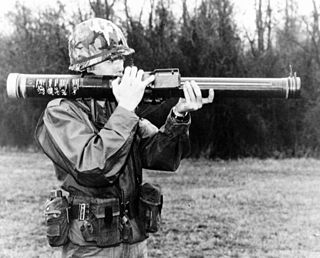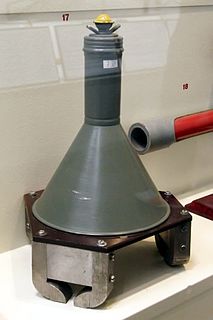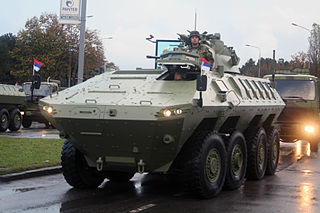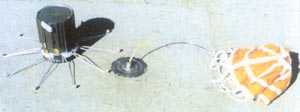
A tank destroyer or tank hunter is a type of armoured fighting vehicle, armed with a direct-fire artillery gun or missile launcher, with limited operational capacities and designed specifically to engage enemy tanks.

A land mine is an explosive device concealed under or on the ground and designed to destroy or disable enemy targets, ranging from combatants to vehicles and tanks, as they pass over or near it. Such a device is typically detonated automatically by way of pressure when a target steps on it or drives over it, although other detonation mechanisms are also sometimes used. A land mine may cause damage by direct blast effect, by fragments that are thrown by the blast, or by both.

The BMP-1 is a Soviet amphibious tracked infantry fighting vehicle. BMP stands for Boyevaya Mashina Pekhoty 1, meaning "infantry fighting vehicle". The BMP-1 was the first mass-produced infantry fighting vehicle (IFV) of the Soviet Union. It was called the M-1967, BMP and BMP-76PB by NATO before its correct designation was known.

Anti-tank warfare arose as a result of the need to develop technology and tactics to destroy tanks during World War I. Since the first tanks were developed by the Triple Entente in 1916 but not operated in battle until 1917, the first anti-tank weapons were developed by the German Empire. The first developed anti-tank weapon was a scaled-up bolt-action rifle, the Mauser 1918 T-Gewehr that fired a 13mm cartridge with a solid bullet that could penetrate the thin armor of tanks of the time and destroy the engine or ricochet inside killing occupants. Because tanks represent an enemy's greatest force projection on land, anti-tank warfare has been incorporated into the doctrine of nearly every combat service since. Most predominant anti-tank weapons at the start of World War II were the tank-mounted gun, anti-tank guns and anti-tank grenades used by the infantry as well as ground-attack aircraft.
The M4 Sherman tank was produced in several variants and it was also the basis for a number of related vehicles. In addition, Shermans have been modified by several nations from modernization upgrades to complete hull conversions for another task.
The PRB M3 and PRB M3A1 are plastic cased minimum metal anti-tank blast mine produced by the Belgian company Poudreries Réunies de Belgique in the 1970s and 1980s. The mine is square with an olive drab body constructed from polythene with a webbing carrying handle on the side and an ammonia-free bakelite seating for the pressure plate to be screwed into. The fuze well is in the centre of the seating, with the pressure plate screwed into it after the fuze has been inserted. The cylindrical pressure plate consists of two plastic plates, one of which moves under the weight of a vehicle driving over the mine to transmit the force to the fuze, shearing pins which hold it in place.

The MN-111 is a Polish air-dropped anti-tank landmine. The mine is designed for use on soft ground. The mine is cylindrical with six spring-loaded fins attached to one end of the mine, with the cylinder drawn to a point at the opposite end which is topped with a small wind vane. The mine is stored with the fins wrapped round the outside of the mine. Once the mine is dropped from the aircraft the fins spring outward, acting as a drag parachute, slowing the rate of descent to a peak speed of about 60 meters per second. As the mine drops the wind vane spins, generating the power used to arm the mine.

The BOV, is an all-wheel drive armoured vehicle manufactured in the former Yugoslavia and today in Serbia. Currently in development is second generation BOV.
The PTM-3 is a Soviet scatterable anti-tank mine that can be deployed either by hand, vehicle, artillery, or helicopter. The mine's case is configured to produce a shaped charge effect on five sides.

The Hafthohlladung, also known as the "Panzerknacker" was a magnetically-adhered, shaped charge anti-tank grenade used by German forces in World War II, sometimes described as a mine.

The Fahd is a 4x4 Egyptian armored personnel carrier, designed to fit the requirements of the Egyptian Military. It replaced older APCs in Egyptian service such as the BTR-40, and the Walid. It has been used by eight nations including Egypt, besides being used by the United Nations.

The Lazar BVT is a Serbian mine resistant ambush protected vehicle (MRAP), manufactured by Yugoimport. Named after Prince Lazar Hrebeljanović, a 14th-century ruler of Serbia.

The SPG Kalina is a heavy, multi-purpose armoured personnel carrier designed at the OBRUM and is produced by the Bumar Łabędy company - part of Polish military consortium - Bumar Group. SPG is a development of the joint Poland, Soviet Union and East Germany transporter called MT-S, developed in the late 1980s.

The RG Outrider, also known by its original designation RG-32M Light Tactical Vehicle (LTV), is a 4x4 multi-purpose mine-protected armoured personnel carrier (APC) manufactured by BAE Systems of South Africa. It was first introduced in early 2009 as the RG-32M LTV, and was first purchased by Ireland. The vehicle was offered to the US market the following year, re-designated as RG Outrider. It is based on and is the successor to the RG-32M already in service in Afghanistan with the coalition forces. The RG Outrider offers several improvements over its predecessor, including the addition of the V-shaped hull.

The Aravis is an infantry mobility vehicle developed and built by French company Nexter. An order for 15 Aravis vehicles was placed by the Délégation Générale pour l'Armement in April 2009 for use by the French Army as a reconnaissance and escort vehicle for engineer units. Deliveries for the initial order began in January 2010.

The Mahindra Mine Protected Vehicle-I (MPV-I), is an Indian MRAP-type armored personnel carrier manufactured by Defense Land Systems, a joint-venture of Mahindra & Mahindra Limited and BAE Systems, the first vehicle made under the venture. It is an improved Casspir variant built under licence.

LAZAR is an 8×8 multi-role military vehicle family produced by the Serbian defence industry company Yugoimport SDPR.

The Wer’wolf MK2 is a Namibian designed and built MRAP vehicle that offers protection against small arms fire and land mines. The vehicle uses a MAN chassis, axles and engine. The Wer'Wolf MK2 is a modular vehicle. It is built with a crew compartment that seats three people plus a driver and a rear flatbed configuration. The flat bed configuration allows for different modules to be fitted. It is suited for rough terrain, in APC configuration the Wer'Wolf MK2 can carry up to 10 passengers plus the driver. Designed and built in 1998 it was the first Mine Protected Vehicle manufactured by Windhoeker Maschinenfabrik after it was bought by Government of Namibia.

















